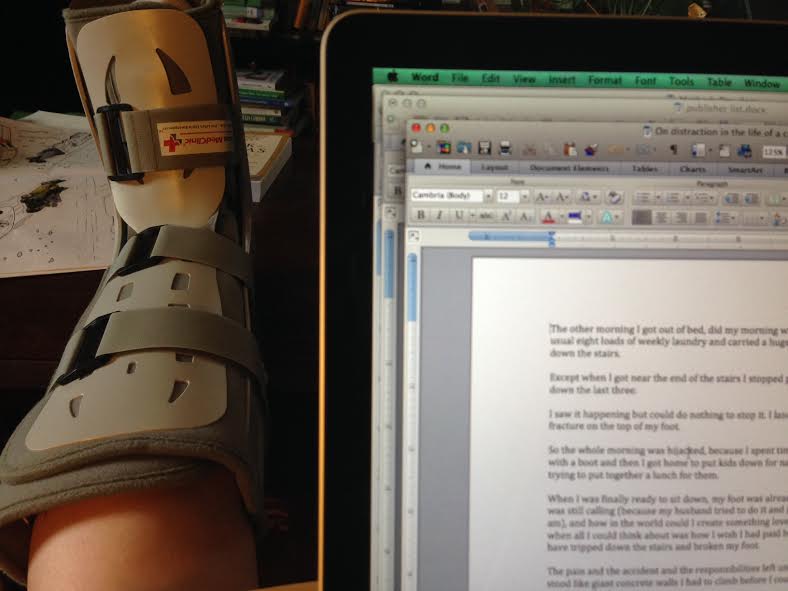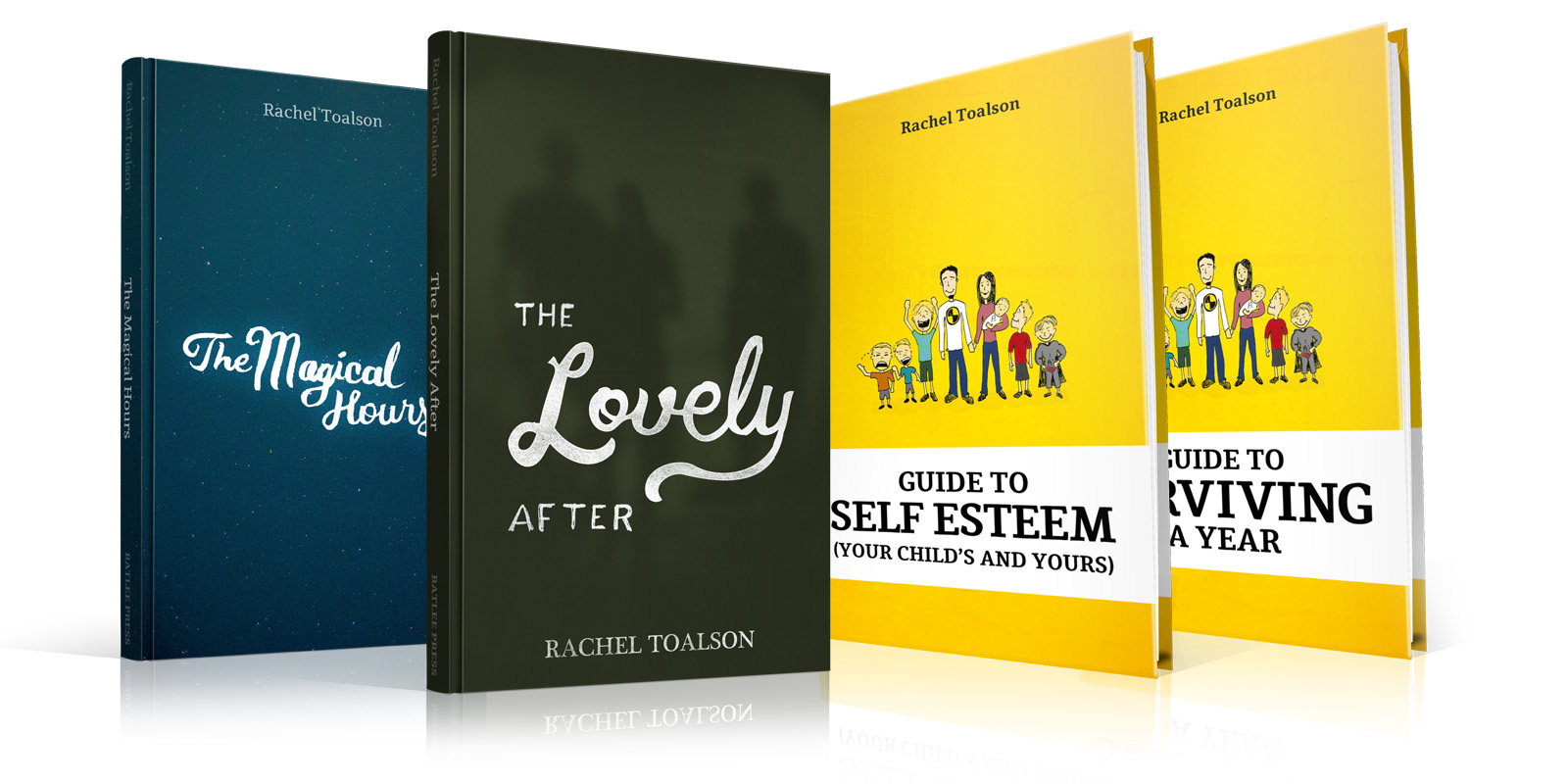
by Rachel Toalson | This Writer Life
The kids are home for summer break, and time feels shorter than ever.
During the school year, we put the boys at home on a strict schedule: breakfast, lessons, playtime, lunch time, nap time and free play in the afternoon.
But during the summer, the time is a little more fluid, which means all those areas where I usually take some work time to catch up on whatever I can with divided attention no longer exist.
The summer is different, because the entire dynamic of our house changes. Time feels tied in knots, with six of them asking for help and making a mess and running wild, instead of just four.
This is the dilemma for every parent writer. We want time to write, but there just aren’t enough hours in the day.
One of the most difficult things we’ll have to do as a writer parent is make space for our writing.
Because there are always dishes to do and children to put to bed and time we need to spend with our partner, and where in the world can we find the time to pursue our writing?
I got up at 5 a.m. today, because it was the first day of summer vacation, and surely my children would sleep until 7 or so. That would give me at least two hours to work on some reading and writing.
Except they woke up at 6 a.m. instead of 7, and I was right in the middle of something I needed to do when they came tearing into the room.
Some days, I swear. It just feels…impossible.
People tell me all the time that they just don’t have the time to do what they love. But if we really love doing it, won’t we find the time?
When people ask me how I possibly find the time to write so much and read so often, I have a pretty short answer for them:
I have to.
I have to read and write to become a better writer, and I have to read and write to become a better person.
I am not who I was made to be if I’m not reading and writing in the spaces of my life. But I had to make those spaces. I had to talk about them with my family. I had to ask for their help.
My boys know the days I didn’t get to read and write much, because they can tell. I am grouchier, touchier, more easily annoyed.
They wouldn’t know how to say it in words, but they like me better when I’ve made space to do what I love.
So how do we make space when it feels impossible?
1. Enter into an open conversation with family members.
If our children and our partner don’t know about our dreams or how important they are to us, they will not give us the space to create. If they don’t give us the space to create, or if expectations are not talked about and worked through, we run the risk of feeling bitter about what time we do or don’t get. It’s worth it to open a conversation exploring times when you might be able to work, whether it’s early morning or late night or the middle of the afternoon while someone else watches the kids.
2. Brainstorm solutions for who has kid-duty.
None of my boys are old enough to be unsupervised for any stretch of time beyond about five minutes (even if they were, I don’t know if I’d trust them). So my husband and I worked out a solution early on. We trade off kid-watching hours during the day. He works seven hours in the morning (beginning work at 6 a.m.), and I take the rest in the afternoon (ending work at 5:30 p.m.). Sometimes we work early, early mornings or late nights. We piece together the hours we need, and we gain the benefit of learning the meaning of true partnership and enjoying the best years with our children.
3. Use time wisely.
Sometimes all we’re going to get in a day is 30 minutes. That means it’s especially important to use that time in a way that will get us what we need and want, whether that’s specific word counts or just a quick essay we can post. Know what you’re going to work on before the time comes around so you don’t spend the whole 30 minutes trying to figure that out. So much can be done in 30 minutes of uninterrupted time. Make sure it’s the right kind of work, and not work you could do while watching your kids.
4. Remember it may not look perfectly.
Sometimes kids will interrupt. Sometimes they will wake up too early or stay up too late. Sometimes we won’t get a dang thing done because we’re just so tired. That’s okay. Get back on the road tomorrow and try again. If interruptions are normal occurrences, try to get someone else to watch the kids while you work. It’s worth it for your family and yourself.
Making space is possible, but we can’t do it alone. We have to ask for help.
But our lives—and careers—will only change for the better.

by Rachel Toalson | This Writer Life
Lately I’ve been having trouble finding balance.
I have heard it said that in order to be prolific at what we do, balance is not something we can achieve. But I don’t believe it. Or maybe that’s just not the kind of prolific I want. Balance is important in my life.
As writer parents, it’s essential that we find balance in both our professional and personal lives.
Parenting can feel all-consuming, because those babies are precious, and they don’t stay little for long, and shouldn’t we be using the time we have to just enjoy everything about them?
And writing can feel all-consuming, because those stories come knocking, and it’s not easy to put down the pen once we get started, and writing isn’t always something we can do in bits and pieces and fits and starts, and shouldn’t we be using the time we have to create?
Balance can sometimes feel impossible when kids are sick or the epiphany we had while making breakfast flew right out of our heads while we were opening our notebook to write it down.
Today, while my kids were playing with cars right in front of me, I was crafting pitches to send out to various publications. And right in the middle of my writing, that voice came creeping in.
Shouldn’t you be enjoying the last mornings you have with your boy?
My third son will go to kindergarten in August, and lately I’ve been meaning to spend more quality time with him, because in two more days his big brothers will be out of school and this house will turn into a madhouse.
At the same time, this house will turn into a madhouse, and my work will slow down, so if I want to get these pitches done and out, I need to do them now.
I feel this tension all the time—play with my kids or try to get more work done.
There’s always so much work to do and so many new things to learn about in the life of a writer, and there is always so little time in which to create and still enjoy my children without deadlines hanging over me.
It’s possible to achieve balance, but it may look differently than we think it should.
Here are some ways I’ve tried to find balance in my writer-mom life.
1. Quit looking at the competition.
There are many writers out there cranking out stories at an impressive rate. Many of them are not parents. We should stop trying to be like them. We move at our own pace. Maybe we can’t write a book every 30 days or 60 days or 200 days. That’s okay. If we are doing the daily work of it, we will, eventually, have a book.
We have time restraints, and sometimes that can seem like it’s a handicap. But according to research, restraints can be good for us. They can make us more creative, if we use them to our advantage.
2. Invite the children in.
If you’re having trouble achieving balance, invite your children in to your work. My children know that, every morning at 8:30 a.m., we will listen to an audio book while I gaze lovingly at my four-month-old during his feeding, because reading makes me a better writer.
They know that once a week, during Family Time, we will have a writing night—and sometimes that means collaborating on a story together and helping Mama work out a plot line where she’s stuck. Sometimes it means reading excerpts from writing books we’ll read together.
There is something sacred about that shared space.
3. Establish set hours.
Parents who work from home can have a tough time with balance if we have no set hours. My kids know that from 9-9:30 a.m. I am catching up on emails and business matters, but the rest of the morning, I am available to them. If I receive an email outside of those morning “office” hours, it can wait until later.
They know that during their naps and Quiet Time I will be working but am available for emergencies. They know that from 1 until 5 p.m. their daddy is on duty.
If I am doing any business outside of those hours, they will call me on it.
Sometimes, when a deadline is looming, it’s necessary to work on finishing a story during Family Movie Night, but open lines of communication are important for those instances when office hours creep into family hours. We don’t ever want our children to believe that our work is more important to us than they are. But we do want them to understand that our work is important.
4. Adjust your mindset.
Some days we just won’t get a whole lot of work done, because a boy was feeling sick or lonely or doubly mischievous. If we can shift our mindset from “I didn’t get everything done that I needed to get done today” to “Today’s work is enough for today,” we will be happier people, and so, by extension, will our children.
Balance and brilliance are not opposite poles. They can exist together. But it will take great intention and focus and compromise.
It’s a good thing we’ve already mastered that as parents.

by Rachel Toalson | This Writer Life
There are many great online blogs that use writers as contributors, but few of them with the reach of The Huffington Post. To get a spot as a blogger for Huff Post is one of the most desirable gigs a writer can get.
In December of last year I decided I wanted to start pitching blogs to some large-traffic sites. The first one I tried was Huff Post.
I had already done a ton of research, because I know it’s required before a writer can effectively pitch to a large publication like Huff Post (in fact, I recommend spending a few weeks getting familiar with the publication’s articles and the style and tone in which they’re written). I combed through the Huff Post Parents site, clicking on the features and trying to get a feel for what might do well on the blog. After a few days, I had an article in mind.
One of the great things about Huff Post is that blog editors accept previously published material, which means that what you post on your own personal blog can be used on Huff Post. My first pitch was an essay I’d written for my parenting blog, Crash Test Parents.
After digging around for a while, I found an e-mail address for the blog editors (blogteam@huffingtonpost.com), rather than the generic contact form (an actual e-mail address is always better). Then I crafted several versions of my pitch. It was my first pitch, and I wanted to get it perfect.
Here’s the one I finally settled on:
Dear Blog Team,
Thank you for taking the time to read my note. As a mother of five (going on six) boys, I hear many jokes from people who know me or don’t: “You know what causes this, right?” “Every time I see you you’re pregnant!” “Do you guys have a TV?” The most hurtful one, I think, is the “Well, my wife and I believe in family planning.”
So I wrote about this misconception in an article called “Just Because I Have a Large Family Doesn’t Mean I Didn’t Family Plan.” I have attached my piece to this message and greatly appreciate the consideration.
There are a few things I would do differently in this pitch today, now that I have so many under my belt. I would probably include a word count (Huff Post blog editors prefer blogs with 800 words or fewer). I would probably add a little information about me. I would change the word “hurtful” to “annoying.”
Five weeks went by and I heard nothing. And then, on the day I’d made a note on my to-do list to try another pitch (because if you fail, keep on trying), I heard from a blog editor, who asked me to join the Huff Post Parents team.
My first article printed at the end of January (almost two months after I pitched it), and was a feature right out of the gate. It resulted in more than 200 comments and more than 1,200 Facebook shares, 25 tweets and 17,000 likes.
I’ve been blogging for them ever since.
Huff Post doesn’t pay you for your blogs, but reusing your blogs can make that time worthwhile. They allow links to your original material, which can draw people onto your own platform (always the goal).
Traffic to my web site increased dramatically once I joined the Huff Post Parents team, because people who liked my article wanted to see what else I’d written.
Once you become a blogger for Huff Post, you get a blogger profile and can submit blogs as often as you want. I try to submit them at least once a week, although the publishing schedule varies, and I don’t always have one article posting every week. Sometimes blog editors are inundated with submissions and a blog can sit in a queue for six weeks or more.
One of the biggest drawbacks, for me, is that many of the people who comment aren’t always the nicest people. I tend to have a pretty thin skin, so sometimes it gets to me. But if you can step away and answer their unkindness with kindness, you win others to your platform.
Overall, Huff Post Parents and its other affiliates (I’ve since been published on Huff Post Education and plan to pitch a few to Huff Post Religion) is a good move for visibility and introducing others to your platform.
Important tips:
1. Make sure you have an engaging headline. If blog editors don’t know who you are, the first thing they’ll see in your pitch is the blog title. Make them want to read it.
2. Clean your copy. Make sure your copy is free of errors. It just makes working with you much easier for these editors who deal with thousands of queries and blogs every day.
3. Try and try again. If more than six weeks goes by, try another pitch. Keep trying until you get something accepted. But don’t keep trying without looking at what might be unappealing about your pitches–whether it’s the article or your e-mail. Analyze and learn from every rejection.

by Rachel Toalson | This Writer Life
The other morning I got out of bed, did my morning writing, worked out, sorted the usual eight loads of weekly laundry and carried a huge hamper full of dark clothes down the stairs.
Except when I got near the end of the stairs I stopped paying attention and tripped down the last three.
I saw it happening but could do nothing to stop it. I landed so hard I got a hairline fracture on the top of my foot.
So the whole morning was hijacked, because I spent time with a doctor and time with a boot and then I got home to put kids down for naps after hobbling around trying to put together a lunch for them.
When I was finally ready to sit down, my foot was already throbbing, and laundry was still calling (because my husband tried to do it and just isn’t as good at it as I am), and how in the world could I create something lovely and eloquent and useful when all I could think about was how I wish I had paid better attention so I wouldn’t have tripped down the stairs and broken my foot.
The pain and the accident and the responsibilities left undone because of them stood like giant concrete walls I had to climb before I could focus on creating anything of value.
Sometimes artists have days like this.
Sometimes the kids get sick, and we worry about them and they just want to be near us and creativity flies right out the window every time they cough in their sleep or try their hardest to make it to the bathroom and inevitably fail so it’s all over the carpet instead.
Sometimes the doorbell will ring when we’re right in the middle of flow, right in the middle of writing a word, because the lawn team mowing our neighbor’s yard noticed you might need help with ours.
Sometimes we will trip on our way down the stairs or smash our finger in the car door or cut our hand trying to slice an apple.
Distractions will come in the life of artists—because we are living life (and if we aren’t, our art suffers anyway).
We can’t avoid the distractions, so we must learn to overcome them.
The thing is, we can be made better artists on the hard-to-create days.
If we create anyway.
Because do you know what distraction learns in our creating anyway? It learns that it has no real power over what we decide to do, no real power over us.
What distraction wants is for us to give in. Stop creating. Put it off until tomorrow, or the next day or the one after tha tone.
We can’t. We won’t.
We will create anyway.
Even if we can feel our heartbeat in our foot, we will create. Even if the doorbell rings, we will create. Even if the baby didn’t sleep last night, we will create.
What we create in the face of distraction may not be our best work or even close to it, but it is still practice. It is still valuable.
Distraction still doesn’t win the day.
So that day, even though my foot throbbed and my brain felt foggy and my words didn’t want to come out from hiding, I wrote.
I threw everything out, started over from the beginning all the days after, but I still made something out of nothing.
Distraction did not win.
Challenge: Think of your most common distraction. Write a letter to it. Be serious or funny, but most of all be honest. Tell it you will create anyway—and then do it.

by Rachel Toalson | This Writer Life
Every morning at 4:30 I crawl out of bed and reach for my glasses (usually knocking a book or two off my bedside table) and trip to my blue wing chair, where I turn on the lamp and open my morning notebook.
And then I write three pages—about 900 words—on whatever comes to mind.
I have no agenda. No purpose. I just write.
It’s an idea I got from Julia Cameron, a creativity teachers and author of The Artist’s Way. Cameron calls these writing sessions “morning pages.”
When I first read about them in one of her books, I was skeptical. She advocates that you get out of bed half an hour earlier than normal, and, good grief, I already got out of bed at 5. I wondered how I might possibly benefit from less sleep and more writing, when I already wrote nonstop between the hours of 12:30 and 5:30 p.m. Wasn’t that enough?
Still, I decided to give it a chance.
I’m hardly ever completely awake when I’m doing my morning pages, but I have never had to search for anything to say—mostly because the point of morning pages isn’t really to say something profound or true or worth using later (although sometimes that will happen naturally).
The point is to clear a cluttered mind.
I think of them as my writing meditation.
In my morning pages, I unload all the stress that weighs on my subconscious—that payment a client has yet to make, my little boy’s complaint about his tummy hurting last night, how I really don’t want to take on that assignment but feel a little pressured to.
Every now and then a new story idea or an essay topic will find its way into my pages, but that’s never the goal.
The goal, at its simplest, is to clear a mind of it unnecessary weight so we will have more room to create and move and make beauty for the world.
When we are so weighed down by worries and concerns and things to do, we cannot freely create our art.
So writing first thing in the morning, to break free of those weights, is not just for writers. It’s for all artists.
Creativity begins with writing.
When we write, whether it is a record of our day or a 100,000-word story we’re trying to sell, our world becomes clear. We find ourselves in words, in all the poetry that finds its way into choppy sentences or long, flowery ones that say something or nothing at all.
Writing opens up space in our minds so we can envision more and dream bigger and create in a new dynamic.
It’s up to us how that writing is done. I do it in a composition notebook, by hand—mostly because studies show that the motion of our hands gets our brain thinking more creatively.
But also because when we write by hand, we have a record of our days. We can see our handwriting and how it changed from day to day and mood to mood—how in those days’ records right there, the baby I was holding kept kicking my hand in the middle of a word. And right there is when I felt so passionate about what I was writing that the passion showed itself in hurried handwriting and water splotches. And right there—that’s where I couldn’t write fast enough for the speed at which my brain was working, so all the letters run together in excitement.
My morning pages tell a story of exhaustion and worry and excitement and gratitude and joy and motherhood and creativity and hope.
It is the place where I have written, “I’m tired of doing things for free,” and those words helped me realize I was giving too much of my writing away and not asking enough compensation for my value. It is the place where I have worked out how I would most like to use my gift. It is the place where I have renounced the fear that I will do all this work only to see nothing come of it.
I don’t look back through those early morning pages often, but I plan to. Because there are jewels hidden in my stream-of-conscious writing, and I want to find them.
Writing can make a world clearer. It can tell us more about our true selves. It can help us work out the places where we feel stuck and trapped and too heavy to fly.
All of this informs our creativity.
So get out a notebook and write.
Challenge: Try morning pages for the next month. Set your alarm clock half an hour early (I know, I know how hard it is!) and write without stopping until you have filled three pages. Don’t worry if it sounds petty or trite, or if it doesn’t even make sense because you’re half asleep. It’s better that the petty and trite get down on paper instead of clogging your creativity.
by Rachel Toalson | This Writer Life
 (Photo by Steven Salazar)
(Photo by Steven Salazar)
A couple of weeks ago my husband and I had the privilege of attending a creative conference called Creative South.
All week leading up to the conference I felt anxious and a little overwhelmed, because there was still so much writing work to do, and I could not see how I could possibly get it all done when we were traveling one whole day, so that was a day lost, and we would be meeting people from our creative community another day, and that would be a whole other day lost, and we were going to be tied up in sessions for two whole days after that.
I’d look at my to-do list and everything that needed finishing, and I would get a sinking feeling in my stomach.
And then we spent 18 hours in the car brainstorming topics for the podcast my husband and I will be launching May 7. We brainstormed courses we want to develop about real-life parenting. We brainstormed a marriage book I plan to start writing later this year.
We spent several hours in Georgia coffee shops meeting face-to-face with people in our online community and digging right in to deep, challenging conversations and making new friends.
We spent days in sessions on creative strategies and building platforms.
My to-do list sat neglected, but do you know what?
I came away with so many new ideas for topics and projects and wisdom about how to do things that I finally just had to cut those ideas off (not really. I never cut ideas off. I have a brainstorm binder that’s just a lot thicker now.).
What I’ve found is true in my life is that sometimes we have to step away from our idea of the way things should go so we can embrace a better way we didn’t even know we needed.
There is a point in every creative life when we have been working for so long and in the same environment with the same amount of time and the same people and the same challenges that we become, maybe just a little bit, stale.
Sometimes it takes getting out of the normal routine to find new life in our old creations.
Routine is helpful in the life of a creative. It gives us specific, consistent time in which to create. Every day. Without exception.
But throwing out the routine, every once in a while, is also helpful in the life of a creative. It invigorates our creativity so we can push through to the finish or just remember why we started doing it in the first place.
Julia Cameron, one of the best teachers on creativity, calls these getting-off-routine blocks of time “Artist Dates.” She recommends that artists take one a week.
It doesn’t always have to look like a weekend conference. It can look like a 30-minute break where we get outside our house and see other human faces, besides the ones we see every day, and hear other voices and observe new beauty.
Being a creative can be a lonely life. As a writer, I hole myself away for hours at a time, just working on my craft. Sometimes, if my kids don’t barge in right after school to say hello, I can spend that whole five hour without any human contact whatsoever.
It’s good for me to get out once in a while. It’s good for me to sit beside my husband for an uninterrupted road trip and brainstorm what we’re passionate about. It’s good for me to meet new people and hear new stories and share in new experiences.
The out-of-the-ordinary informs our art just as much as our ordinary.
At the end of our trip, my husband and I had 77 podcast episodes, the beginnings of a new sci-fi novel, a dozen article topics and more. I edited a book, wrote on another novel and wrote fifteen poems.
My to-do list wouldn’t even know what to do with productivity like that.
Sometimes a to-do list can be filled with all the exact right things when we take time away from it.
After all, the unexpected can hold some of our greatest inspiration.
Challenge: Try an Artist Date this week. Take a walk. Visit a bookstore. Have coffee with a friend. Don’t think of it as work time you’re giving up but as time you’re using to inform your work. Our mental shifts can set us up for new perspectives, which, in my experience, is always a win.







